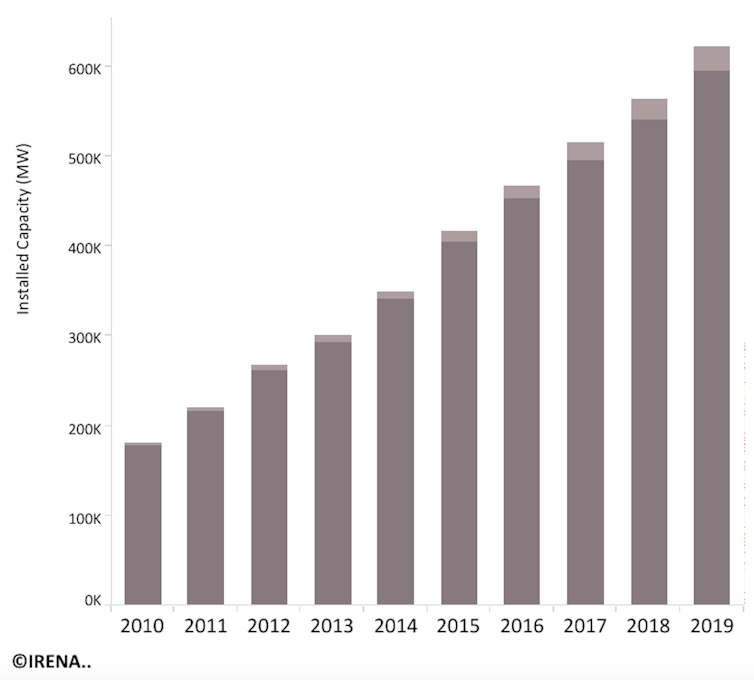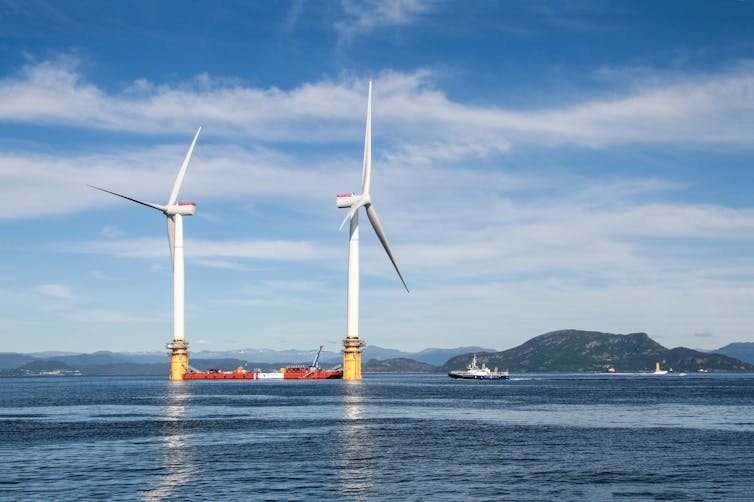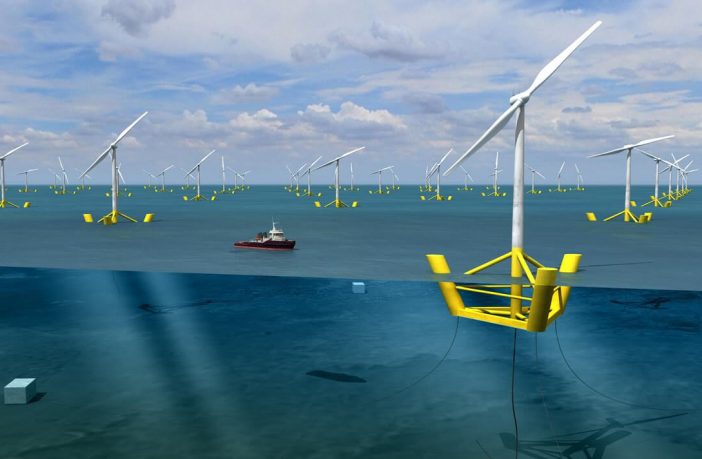Since 2010, wind energy has seen sustained growth worldwide, with the amount of energy generated by offshore wind increasing by nearly 30% each year. Countries around the world need to ramp up renewable energy supply quickly to meet growing demand and rapidly reduce emissions. Despite this urgency, offshore wind currently provides less than 1% of the world’s electricity supply.
Many of the prime shallow-water locations for building wind farms are being developed. But the potential of offshore wind still remains largely untapped, per the graph of worldwide installed capacity below.
Onshore vs offshore wind capacity

IRENA, Author provided
The reason for this untapped potential is that 80% of the wind blows uninterrupted further offshore – in water deeper than 60 metres, where turbines embedded in the sea floor are tricky to construct.
The solution could be floating offshore wind farms. So what’s holding them back?
Floating offshore wind
All bar a handful of existing offshore wind turbines are attached to the seabed by a fixed foundation – mostly a large steel tubular pile that transitions to the turbine mast above the seabed. These so-called fixed-bottom turbines are limited to water depths of 50 or 60 metres.
But recent projects, including Hywind off the coast of Scotland and Windfloat off Portugal, show that it’s possible to build floating wind turbines. A single six megawatt turbine – like those used in the Hywind farm – can generate enough electricity to power 4,000 UK homes.
But to provide equivalent household electricity for a global population of 9 billion by 2050 would require something like half a million offshore wind turbines – a 100-fold increase on the current number – plus the extra capacity to provide electricity for future energy demand.
Unfortunately, while floating wind farms are technically feasible, they’re not economically viable. Doing anything offshore is expensive. To build a one gigawatt fixed-bottom wind farm, the cost of completing the necessary site survey is in the region of £15 million. Installing and commissioning the farm would be about £650 million, while the ongoing costs for operation and maintenance would be roughly £75 million per year. At the end of its life, which may be about 25 years, there’s another £300 million necessary for decommissioning.
Yet floating wind farms, which are still in the early days of their design and technology, are even more expensive. Whereas the price for delivering offshore wind energy in 2019 ranged between £36 and £45 per MWh of electricity, current auctions for floating wind are priced over twice that amount.
Offshore structures are also very big. The Hywind six megawatt turbines are 154 metres in diameter – each blade is the same length as an A380 aeroplane wingspan. The Siemens Gamesa 10 megawatt turbine has a rotor diameter of 193 metres, while the US National Renewable Energy Laboratory 15 megawatt reference turbine has a diameter of 240 metres. Constructing, installing, operating, monitoring, maintaining and decommissioning infrastructure of this scale, in the ocean, is no trivial task.

While energy companies often build far out at sea, a single floating wind turbine produces a lot less energy than a single offshore oil or gas rig. Over its operating life, depending on the size of both structures, it could be in the range of 1,000 times less. So a lot more infrastructure is needed for the same energy yield from renewables. Putting an offshore wind turbine out at sea and keeping it there needs to become a lot cheaper to match the cost of energy production from offshore oil or gas.
A lot can be learned from traditional offshore engineering to help with the transition to renewable energy. But the necessary cost reductions cannot be achieved by doing more of the same, or sharpening the efficiency of existing methods and technologies.
Tech solutions
That’s why it’ll likely take new technologies to make floating wind farms cost-effective. For instance, using robots and other autonomous tech to control offshore engineering activities – from investigating the seabed to operating, inspecting and maintaining a floating wind turbine – could reduce the risk to workers and give more efficient control of these complex systems.
Routine inspections of offshore wind farms by people would be impractical on the vast developments being built today, and certainly for those planned in the future. Smart sensors built into all parts of a floating wind farm can continuously assess how the structure is faring instead.
Machine learning – which uses data to teach computers to make decisions on their own – could be used to tell us the most efficient anchor during design, or if a mooring line might be at risk of failure during operation.
Already, machine learning can use weather data to control the positions of turbine blades, to maximise how much energy they generate or prevent damage in high winds or storms. New methods combining physics with machine learning can make reliable predictions with less data, which is useful offshore where data can be difficult to collect.
As the UK government begins an inquiry into the kind of technological innovations that could tackle climate change, offshore wind is the first port of call. With investment in the technology of the future, floating wind farms could help supercharge the country’s, and the world’s, renewable energy capacity.
Author: Susan Gourvenec, Royal Academy of Engineering Chair in Emerging Technologies – Intelligent & Resilient Ocean Engineering, University of Southampton
This article is republished from The Conversation under a Creative Commons license. Read the original article.















